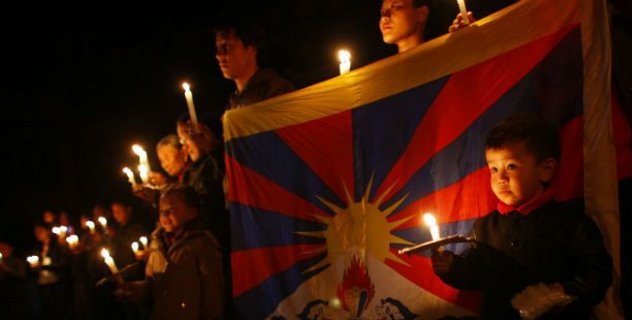
Exile Tibetans participate in a candle light vigil in solidarity with fellow Tibetans who have self immolated, in Katmandu, Nepal/AP
By Ishaan Tharoor, TIME / February 13, 2013
On Wednesday morning in Kathmandu, the capital of Nepal, a Tibetan monk drenched in gasoline appeared in front of a Buddhist stupa popular among Tibetans and set himself aflame. At the time of writing, the young man, thought to be in his early 20s, is in critical condition. According to some reports, his fiery protest marks a grim milestone: it’s the 100th such self-immolation by a Tibetan to happen since 2009 (others suggest it’s the 99th or the 101st). Whatever the ghastly metric, the act has become the signature tactic in recent years of Tibetans voicing their frustrations with Chinese rule. It carries a haunting moral cry no suicide bomber can match. When one downtrodden Tunisian set himself alight in December 2010, the spark of his despair and anger kindled uprisings that swept across the Arab world. Yet, 100 Tibetan self-immolations — and many deaths — later, little has changed.
Part of the problem is where these protests occur. The overwhelming majority takes place within the borders of China, either in Tibet proper or in Tibetan areas of neighboring Sichuan, Gansu and Qinghai provinces. Media access is heavily controlled and much of what we know comes from advocacy groups based outside. A white paper titled “Why Tibet Is Burning,” released last month by an institute affiliated with the Tibetan government-in-exile in Dharamsala, India, identifies by name 98 Tibetans who carried out self-immolations in China since February 2009. Many of those choosing to set themselves on fire are young teenagers and 20-somethings. They are farmers and aspiring clerics, nomads and students. In a foreword to the study, Lobsang Sangay, the democratically elected Prime Minister of Tibet’s exiles, urges Tibetans to “not to resort to drastic actions, including self-immolations, because life is precious.” But the study goes on to point the finger at Beijing:
The reason [for all the self-immolations] lies in China’s massive policy failure in Tibet over the course of more than 60 years of its rule. The revolution that is brewing in Tibet is driven by political repression, cultural assimilation, social discrimination, economic marginalization and environmental destruction.
China, of course, doesn’t see it this way. The likelihood of a Tibetan revolution — or even the rioting of not so long ago — is dwarfed by the specter of a Beijing crackdown. Authorities have already started detaining and jailing Tibetans they claim are “inciting” self-immolations; one such swoop earlier this month in the rugged province of Qinghai netted 70 suspects. Quoted by Chinese state media, a local official echoed China’s longstanding critique of any Tibetan dissent: “The Dalai Lama clique masterminded and incited the self-immolations. Personal information, such as photos of the victims, were sent overseas to promote the self-immolations.”
The Dalai Lama, the increasingly withdrawn spiritual leader of Tibetans-in-exile, has long promoted a “middle way” of dialogue and nonviolent resistance, and has also urged against Tibetans carrying out self-immolations. According to a BBC report last year, the steady toll of self-immolations was being interpreted by some angry Tibetans overseas as a sign that the Dalai Lama’s timid, largely failed policies of engagement ought to be given up. “Violence could now be the only option,” said one influential Tibetan activist to the BBC.
That’s a scenario that could spell even more trouble for Tibetan aspirations — resistance to Beijing has been met ruthlessly with arrests and media blackouts. No foreign government would risk their relationship with China over tacit support for an aspirational and unlikely Tibetan nation. The governments of India and Nepal, which play awkward hosts to generations of Tibetan exiles and dissidents, routinely crack the whip on Tibetan activists, breaking up protests and monitoring exile activity. Geopolitical conflagrations elsewhere — from the Senkaku Islands contested by Tokyo and Beijing to the South China Sea to NATO’s imbroglio in Afghanistan — have cornered the international community’s attention.
What’s left then is a lonely struggle. China touts the wealth and development it’s bringing to the Himalayan plateau, but Tibetans abroad see the hollowing out of their homeland, which faces a steady influx of Han Chinese settlers. Here’s the white paper from Dharamsala once more:
[Tibetans] look on with alarm and fear as Chinese settlers stream into Tibet, taking away Tibetan jobs, land and their very future — and in the process, transforming Tibetan towns and cities into so many Chinatowns … At the same time the Tibetan people see massive development activities undertaken on their land that bring little or no benefit to them and aimed, instead, to cart away Tibetan natural resources to a resource-hungry China. In fact the policies of the Chinese Communist Party demonstrate to the Tibetan people that China wants Tibet but not the Tibetan people.
http://tibet.net/2013/03/02/how-many-self-immolating-tibetans-does-it-take-to-make-a-difference/